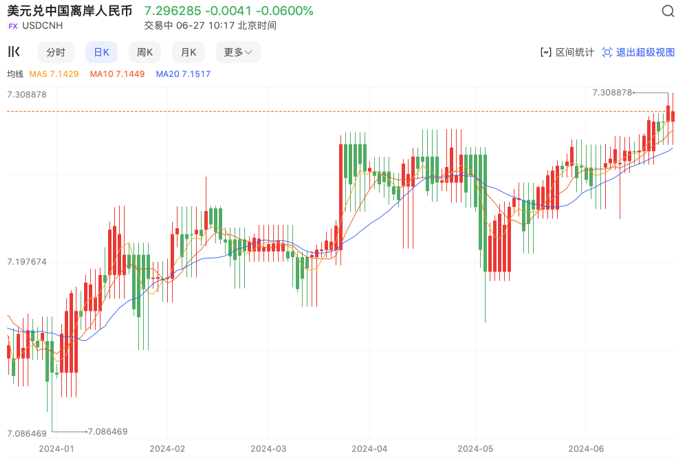The RMB exchange rate fell to a new low in seven months. What's the next?
A few days ago, the dollar continued its strong performance against the renminbi in previous months. On June 26, as the the US Dollar Index soared, the exchange rate of the offshore RMB against the US dollar fell below 7.30 intraday, and the lowest point hit 7.308878. This is the first time since November 15, 2023 that it has broken through the above-mentioned mark.
As of 07:00 on June 27, the offshore RMB exchange rate against the US dollar temporarily rose to the level of 7.298813, but the market is cautious about the prospect of a rebound in the RMB exchange rate. Why has the exchange rate of RMB against the US dollar declined recently? In fact, this phenomenon is caused by the interweaving of multiple factors.
Chart: USD/Offshore RMB Trend
The U.S. dollar continues to be strong, and the pressure on the renminbi has increased significantly
The driving force for this round of RMB decline is mainly the surge in the US Dollar Index. While the exchange rate of RMB against the US dollar has reached a new low, the US Dollar Index has also stabilized at 105 in recent days and once broke through the high of 106. The impact effect of a strong US dollar is still spreading.
The continued strength of the U.S. dollar not only affects the exchange rate trend of the renminbi, but non-U.S. currencies are also generally under depreciation pressure. For example, the dollar fell below the integer mark of 160 against the yen yesterday, hitting a new low since 1986, and the depreciation pressure on the yen intensified.
If we further explore the reasons for the appreciation of the US dollar, we can find that it is closely related to factors such as the weakening of the Fed's interest rate cut expectations, the market is bullish on the US dollar and short-selling emerging market currencies, and the continuous escalation of the Palestine-Israel conflict and the Russia-Ukraine conflict.
At the interest rate meeting in June, the Federal Reserve continued to maintain Federal Funds rate's target range at 5.25%-5.5%. The Fed's "stand still" behavior has made the market expect that the timing and magnitude of interest rate cuts this year will be delayed and narrowed.
At the same time, the European Central Bank and the Bank of Canada took the lead in cutting interest rates by 25 basis points, and the Bank of England may also start cutting interest rates in August. These have virtually strengthened the trend of the US dollar.
In addition, the substantial increase in the seats of European far-right parties in the European Parliament, the escalation of the Palestine-Israel conflict and the Russia-Ukraine conflict have all exacerbated investors' concerns about the uncertainty and risks of emerging markets.
Under the combined effect of these factors, funds began to flow from emerging markets to relatively stable U.S. assets, which pushed up the U.S. dollar and indirectly affected the RMB exchange rate.
The central bank released a signal to maintain stability, where will the RMB exchange rate go?
In the context of intensified exchange rate fluctuations in the global financial market, the People's Bank of China has shown firm determination and once again took action to stabilize the exchange rate.
Some people in the industry said that the renminbi has the basis to maintain basic stability at a reasonable and balanced level. This confidence stems from the solid fundamentals of the Chinese economy, the strong resilience of the market, more sufficient tools to stabilize the exchange rate, and the rich experience accumulated in the face of challenges. response experience.
In the face of fluctuations in the exchange rate market, CME group's USD/Offshore RMB futures contract (CNH) $CME USD/CNH - main 2409(UCHmain)$
is one of the useful tools for hedging and managing risks. The product has a variety of contract sizes, providing greater trading flexibility and wider market participation; One of the fastest growing currencies in the world can be operated almost 24 hours through CME Globex; Standard-size contracts qualify for large trades, with three-year maturities that allow for more effective management of long-term exposures.
$NQ100 Index Main 2409 (NQmain) $$Dow Jones Main 2409 (YMmain) $$SP500 Index Main 2409 (ESmain) $$SG RMB Main Company 2409 (UCmain) $$Gold Master 2408 (GCmain) $

Comments